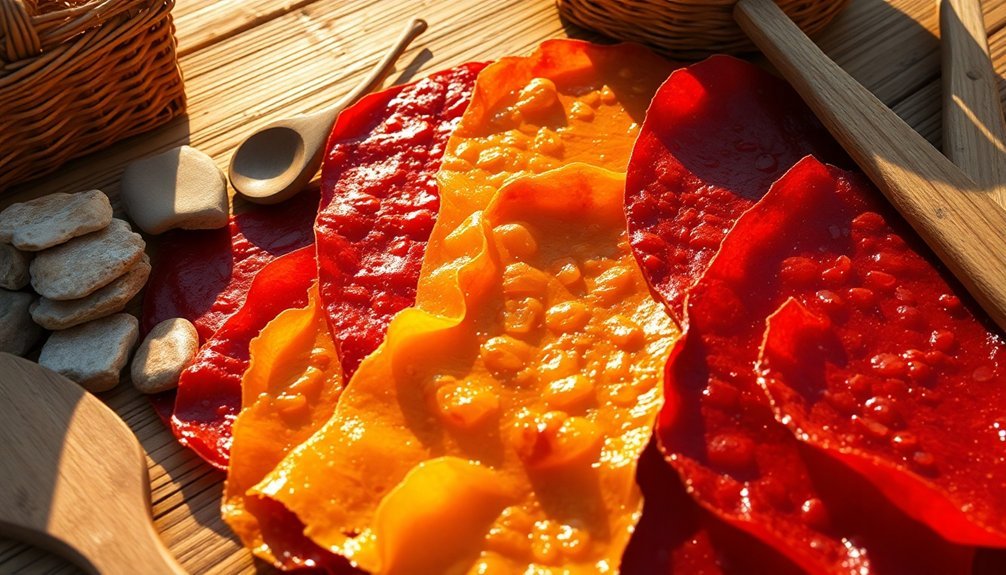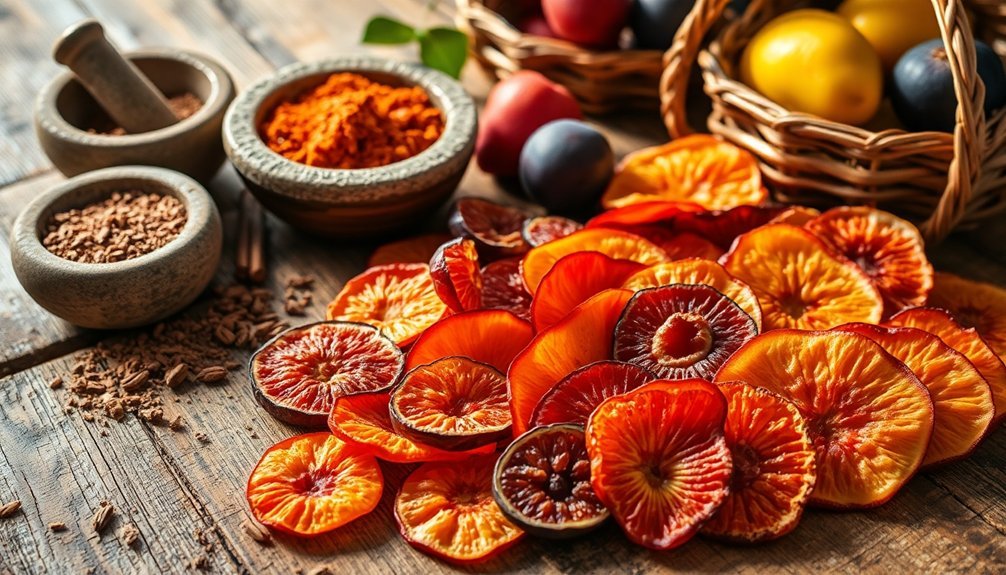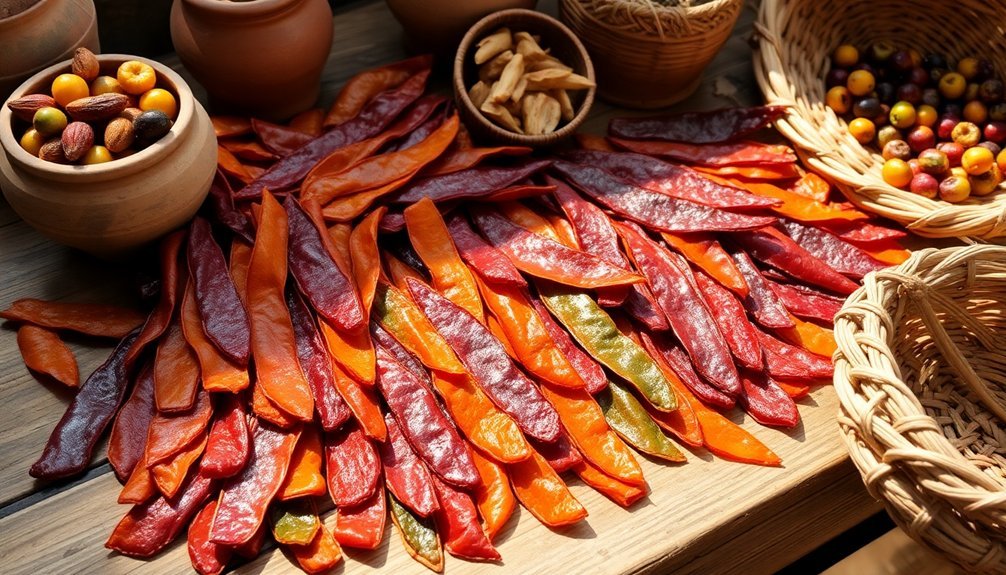Early cultures crafted fruit leather by sun-drying high-pectin fruits like apples and apricots, giving them a robust texture. They often used natural sweeteners like honey for flavor and flexibility. The preparation involved cooking fruits over low heat, pureeing them, and then drying the mixture on trays. Traditional methods included sun drying, oven drying, or using dehydrators. To enhance taste, they added ingredients like lemon juice and salt. Once dried, they stored the fruit leather in airtight containers, making it a convenient snack. There's much more to explore about the techniques and variations in fruit leather preparation!
History of Fruit Leather

Fruit leather has roots that stretch back to ancient times, originating in the Middle East where early civilizations discovered the art of preserving fruit by drying it in the sun. You'd find this practice documented in historical records, highlighting how people harnessed the sun's power to create a durable snack.
As trade routes expanded, fruit leather spread throughout Europe and eventually made its way to America with settlers.
The term "fruit leather" reflects its leathery texture and appearance, but it's known by various names across cultures. In Armenian and Turkish traditions, it's called "pestil," "bastık," or "pastegh," with the term "pastegh" first appearing in Middle Armenian around 1227 AD.
In the Ottoman Empire, fruit leather became a popular treat, with recipes varying by region as local spices and ingredients were incorporated. The production of fruit leather involves several steps, including cooking, drying, and packaging to ensure a consistent and enjoyable product.
One of the earliest flavors was likely apricot, showcasing how different cultures adapted the recipe using what was available. This convenient, nutritious snack could be preserved for months without refrigeration, making it a staple for many societies throughout history.
Traditional Preparation Methods
Creating fruit leather involves a series of traditional preparation methods that have been passed down through generations.
First, you'll want to cook the fruits over low to medium heat to soften them and release their juices. Adding a splash of water helps prevent sticking, and cooking times will vary based on the type and ripeness of the fruit. For berries, you might skip cooking entirely before blending.
Next, blend or puree the fruits until you achieve a smooth texture, similar to applesauce. If you prefer chunkier fruit leather, pulse the blender a few times. If you're using berries with large seeds, press the puree through a sieve to remove them. Additionally, using fresh, ripe fruits ensures the best flavor in your fruit leather.
You can adjust the consistency by adding thickeners like applesauce, and a splash of lemon juice enhances flavor while preserving color.
Once you have your puree, spread it evenly onto prepared surfaces like baking sheets or dehydrator trays, keeping the layer around 1/8 to 1/4 inch thick.
Dry the mixture in an oven or dehydrator, checking regularly to guarantee it doesn't become too dry. After it cools, cut it into your desired shapes and store it in airtight containers.
Key Ingredients in Production

When making fruit leather, selecting the right ingredients is essential for achieving the desired texture and flavor. You'll want to start with high-pectin fruits like apples and apricots, as they provide the best consistency. Mixing these with low-pectin fruits, such as peaches, can create a delightful blend.
Using fresh or frozen fruits works, and don't forget to include peels for added nutrition! To enhance the flavor and pliability of your fruit leather, consider these key ingredients:
- Honey for sweetness and flexibility
- Lemon juice to brighten the color and prevent browning
- A pinch of salt to elevate the overall taste
Chia seeds or applesauce can act as binding agents, helping to keep your mixture cohesive.
Adjust the water content based on the juiciness of the fruits you're using. The acidity from lemon juice not only preserves the leather but also adds a revitalizing zing. Additionally, using a dehydrator is recommended for optimal drying conditions, ensuring your fruit leather has the perfect texture and flavor natural sugars in fruit.
Finally, use silicone mats or parchment paper for spreading and drying your puree effectively. With the right ingredients, you can create delicious homemade fruit leather that captures the essence of nature's bounty!
Ancient Drying Techniques
The art of preserving fruits through drying has been practiced for centuries, showcasing humanity's resourcefulness and ingenuity. You might be surprised at the various methods ancient cultures employed to create fruit leathers, each with its unique benefits.
| Drying Method | Description |
|---|---|
| Sun Drying | Utilized sunshine, covered trays for protection, and took several days. |
| Oven Drying | Used low temperatures (around 140°F) for 6-12 hours, often with the door cracked. |
| Dehydrator Drying | Employed at specific temperatures (135°F) for 6-8 hours, using Paraflexx® sheets. |
| Other Drying Methods | Included advanced techniques like microwave drying and cross-flow cabinet dryers. |
| Conditions | Varied from 30 to 80°C with 20-70% humidity, impacting quality and acceptability. |
Each technique required careful attention to details like temperature and air circulation. Sun drying was popular in sunny regions, while oven and dehydrator methods provided alternatives for those lacking sunlight. These methods not only preserved fruits but also enhanced their flavors, ensuring ancient cultures could enjoy nutritious snacks year-round.
Storage and Usage Practices

Proper storage and usage practices are essential for maintaining the quality and flavor of your homemade fruit leather. To guarantee your fruit leather stays fresh, consider the following storage methods:
- Room Temperature: Store in a cool, dry place, away from sunlight. Use airtight containers or glass jars for up to a month.
- Refrigeration: If you won't eat it within a few weeks, pop it in the fridge to extend its shelf life. This may make it slightly crunchy, but it helps prevent spoilage.
- Freezer: For long-term storage, freeze your fruit leather. Vacuum-sealed bags with oxygen absorbers can keep it fresh for over a year.
When wrapping your fruit leather, use nonstick baking or parchment paper. Individually wrap each piece in plastic or wax paper, rolling it tightly and securing it with a strap.
This not only preserves the flavor but also makes it easy to grab a piece when you need a quick snack. By following these storage tips, you can enjoy your delicious fruit leather at its best for as long as possible.
Frequently Asked Questions
What Fruits Were Most Popular Among Early Cultures for Fruit Leather?
You'll find that early cultures favored fruits like apricots, apples, grapes, and berries for making fruit leather. These fruits provided natural sweetness, rich nutrients, and great flavors, making them ideal for preservation and delicious snacks.
Did Early Cultures Use Any Specific Tools for Making Fruit Leather?
Early cultures didn't use specific tools for making fruit leather. You'd simply spread fruits on flat surfaces or mats, using cheesecloth for protection, relying on natural elements to achieve the drying process effectively.
How Did Climate Affect Fruit Leather Production in Ancient Times?
Climate greatly affected your fruit leather production. You needed hot, dry weather and consistent sunlight to dehydrate effectively, while avoiding rain and high humidity to prevent spoilage. Seasonal changes also influenced your fruit selection and drying methods.
Were There Regional Variations in Fruit Leather Recipes Among Early Civilizations?
Yes, there were regional variations in fruit leather recipes. You'd find different fruits, sweeteners, and spices based on local preferences, creating unique flavors and textures that reflected cultural influences and available resources in each area.
What Health Benefits Did Ancient Cultures Associate With Fruit Leather?
Ancient cultures believed fruit leather offered numerous health benefits. You'd find it rich in vitamins, minerals, and fiber, promoting digestive health and satiety while providing antioxidants that helped protect against diseases and support overall well-being.
In Summary
In summary, early cultures crafted fruit leather using simple yet effective methods that highlighted their resourcefulness. By drying fruits through traditional techniques, they preserved flavors and nutrients for longer storage. With minimal ingredients, these societies turned surplus produce into tasty snacks, showcasing their creativity and connection to nature. Today, we can appreciate their ingenuity and perhaps try making our own fruit leather, honoring the time-tested practices of those who came before us.





Leave a Reply